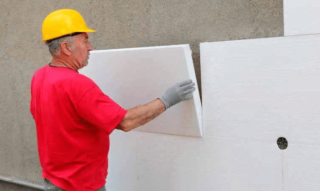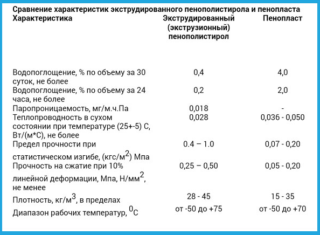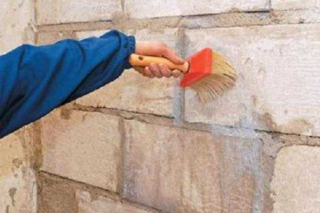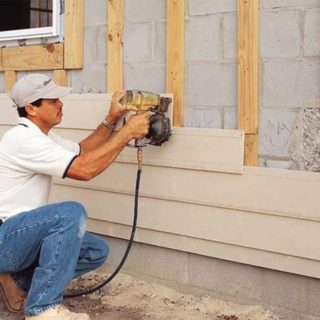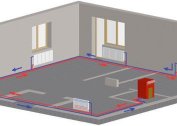Polyfoam has long been successfully used as an inexpensive and effective insulation of the facades of residential and industrial buildings, including private buildings. This material provides good thermal insulation, has a low weight and does not cause problems during the installation process, which allows even beginners in the construction industry to use it. External wall insulation with foam makes it possible to significantly reduce heating costs and create the perfect microclimate in the room. Before the procedure, you should study all the pros and cons of such thermal insulation, choose the appropriate type of material and identify the main nuances of the installation technology.
Pros and cons of foam for external insulation
Polyfoam is a lightweight material, its structure is a foam mass, the main volume of which is air. The density of the foam is much lower than the density of the raw materials from which it is produced. The high air content is an undeniable advantage of the foam, so it has good sound and thermal insulation properties. This is a budget, convenient and easy insulation, which does not cause installation difficulties.
Foam plates are used taking into account their strength levels, with minimal indicators they use additional protection and mount the material in combination with the frame installation method. Foam of increased strength is already protected from mechanical damage, but in this case, it also does not hurt to install the frame.
The list of advantages of foam boards include:
- resistance to water, inability to absorb liquid;
- resistance to the formation of fungi and mold;
- the absence of problems during cutting and installation due to the light weight and optimal structure;
- long term of operation and reasonable cost;
- ability to withstand sudden temperature changes;
- lack of need for installation of a waterproofing.
If the foam is selected for external wall decoration, it is used strictly for its intended purpose and in accordance with the installation technique. Violation of the rules will reduce to a minus all the functions of the insulation.
Which foam to choose
When foam insulation of all external walls and the choice of a suitable type take into account its physical and technical characteristics. It depends on them how well the boards will keep cool and warm, whether there will be problems during installation, the environmental and safety factor for health is also of great importance. The thickness of the plates depends on the type of structure and climate of the region, it is better to choose the average value of the sheets no more than 10 cm. In stores you can find plates with sizes of 40, 50 and 100 mm, they are made to order with other parameters.
It is better to insulate the facade with plates of standard dimensions: 500x1000, 1000x1000 and 1000x2000 mm. They are applied entirely to the walls, cutting material for door and window openings with a knife or file. The density of the foam is its main parameter, which directly affects the scope of the sheets. For construction needs, three types of slabs are produced, indicated by numbers - 15, 25 and 35, designed for the frame method, insulation using the “wet facade” technique and horizontal surfaces, respectively.
Polyfoam is able to catch fire only under the influence of open flame, the time of its independent burning lasts no more than 3-4 seconds. Expanded polystyrene is a more toxic material that emits toxic substances during combustion.
Surface preparation
Warming the house with polystyrene begins with the preparation and leveling of the surface, the walls should be perfectly even with insignificant errors of up to 2 cm.After cleaning, each wall is primed, coated with plaster or treated with concrete contact, the polystyrene plates are additionally prepared and made slightly roughened with a special roller. This procedure is carried out strictly according to the instructions for warming the external walls with foam.
In order to ensure the most even installation of plates along the facade, the zero level is beaten in a circle so that the first rows of sheets lie horizontally. The basement profile provides additional protection against insects and rodents, so its installation should not be neglected. The finishing technology implies its installation using a special level, a zero point on the perimeter of the profile fastening is marked on the facade, after the point is tied together with a chop cord.
Technology of installation of expanded polystyrene
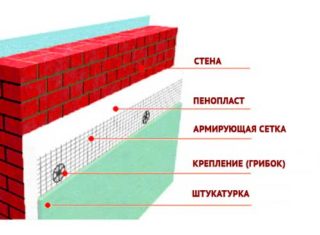 Foam insulation begins with gluing each plate to the facade and its subsequent fastening using plate-shaped dowels. For this purpose, it is better to use a special adhesive designed for polystyrene foam and expanded polystyrene. The glue base is applied in an even layer with a spatula to the wall itself or directly to the plate, sheets can be glued in several available ways.
Foam insulation begins with gluing each plate to the facade and its subsequent fastening using plate-shaped dowels. For this purpose, it is better to use a special adhesive designed for polystyrene foam and expanded polystyrene. The glue base is applied in an even layer with a spatula to the wall itself or directly to the plate, sheets can be glued in several available ways.
Laying begins with window or door slopes, then proceed with the installation of the first row, the position of which is fixed with a basement profile. Plates are mounted in a checkerboard pattern, while paying attention to how tightly they will be fixed. Expanded polystyrene sheets are fixed with dowels, as is polystyrene foam. When fixing the dowels, the following rules must be observed:
- the glue should dry completely, the design is left for a day before proceeding to the next stage;
- dowels are driven into each corner at the joining points of several plates to fix three sheets, one piece will be enough;
- the first dowel is driven into the central part of the sheet, the rest at the corners.
Using styrofoam or polystyrene foam as a heater for walls, it is necessary to take into account the service life of the plates and observe safety precautions. In this case, the insulation will retain its properties throughout the entire period of operation.
Finish finish
At the final stage of the finish, they fill up the seams and cover the walls with plaster or process according to the scheme using the siding technique. Closing all seams is necessary to prevent cold air from entering the gaps between the foam sheets. Large gaps are filled with mounting foam, small ones can be covered with a layer of special plaster. It must be applied to a layer of reinforced mesh, otherwise it will not adhere to the wall. The grid is leveled quickly, since the glue is able to set instantly, so that it is completely covered with plaster, the heater will need to be coated.
Each layer must be applied after the first has completely dried, using a smooth spatula for this purpose. You can take any paint suitable for outdoor structures, apply it to the facade using a foam roller. This stage is final. Polyfoam has many more advantages than disadvantages compared to polystyrene foam. It is able to retain heat well indoors, and it does not get wet and does not create a load on the foundation.
Polyfoam is more appropriate to use for external wall decoration, for internal use the insulation spreads an unpleasant odor, which is why it is considered not environmentally friendly.
Insulation thickness
 In order to qualitatively insulate the walls of the building from the outside, you will need to calculate the thickness and dimensions of the foam sheets as accurately as possible. If the insulation layer is too thin, the walls will freeze in severe frosts.Also for this reason, the dew point will shift inside the room. During this process, moisture-saturated vapors are converted to water. Such a reaction can provoke the deposition of condensate on the inner surfaces of windows and rooms, the formation of fungi and mold. If the walls of the house are too thin, it is better to take plates of maximum thickness. It should be borne in mind that installing a too thick layer is economically disadvantageous, since the costs will be significant.
In order to qualitatively insulate the walls of the building from the outside, you will need to calculate the thickness and dimensions of the foam sheets as accurately as possible. If the insulation layer is too thin, the walls will freeze in severe frosts.Also for this reason, the dew point will shift inside the room. During this process, moisture-saturated vapors are converted to water. Such a reaction can provoke the deposition of condensate on the inner surfaces of windows and rooms, the formation of fungi and mold. If the walls of the house are too thin, it is better to take plates of maximum thickness. It should be borne in mind that installing a too thick layer is economically disadvantageous, since the costs will be significant.
To create high-quality thermal insulation, the thickness of the foam should be optimal. It depends on many factors, including the climatic zone in which the building is located, the thickness of its walls and the material from which they are made. The most important parameter is the thermal resistance of the external walls, this is a constant value, the value of which is presented in the normative tables. This parameter can be determined by dividing the thickness of the foam by the coefficient of its thermal conductivity. Such a calculation will help to find out the required thickness of the material needed to warm a particular building in a particular climate zone.
If the house is built of ceramic bricks in one and a half layers, for such a building the value will be 1.06 m2K / V, the difference in parameters is compensated by using a heater. In this case, the thermal resistance is 2.02 m2K / V. Given that the thermal conductivity of a good foam is 0.039 W (m * K), after multiplying this value by the thermal conductivity, the required thickness of the insulation sheet is recognized, as a result, the required thickness is 78 mm. It is necessary to consider what sizes of polystyrene are on sale. Most often, sheets with a thickness of 50 and 100 mm are used, in this case one side of the wall will be 1000 mm, the other 500, 1000 or 2000.
The process of insulation of external walls can be carried out independently. The time spent on work will depend on the experience of the builder, although everyone can handle this procedure if they have the necessary skills. You can insulate with foam or polystyrene foam the outer walls of the house itself, the attic or the veranda.
The main layer must be done according to the standard, while the top wall decoration can be almost any, depending on the overall design and style of the building. The standard lifetime of the foam is from 20 to 40 years, it directly depends on the quality of materials and installation techniques. When properly handled, the material can withstand 700 cycles of freezing and thawing. Compliance with all the rules and strict adherence to step-by-step instructions will help to avoid gross errors at all stages.
